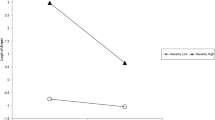Abstract
This paper investigated the theory that withdrawal of employees from organizations represents a gradual process. All hourly non-exempt employees of a manufacturing organization who separated in one calendar year (N =309) were considered. Excused and unexcused absence measures, and excused and unexcused tardiness measures, were collected for seven weeks prior to separation. Patterns of four withdrawal measures were then considered for both voluntary resignations and involuntary terminations, and significant changes over time were found. In addition, polynomial functions were tested, and cubic trends were found to describe profiles of unexcused absences. However, in a practical sense the best description of the process is a sudden upsurge in absenteeism immediately prior to separation.
Similar content being viewed by others
References
Adler, S., & Golan, J. (1981). Lateness as a withdrawal behavior.Journal of Applied Psychology, 66, 544–554.
Atkin, R. S., & Goodman, P. S. (1984). Methods of defining and measuring absenteeism. In P. S. Goodman & R. S. Atkins (Eds.),Absenteeism. San Francisco: Jossey-Bass Publishers.
Beehr, T. A., & Gupta, N. (1978). A note on the structure of employee withdrawal.Organizational Behavior and Human Performance, 21, 73–79.
Bernardin, H. J. (1977). The relationship of personality variables to organizational withdrawal.Personnel Psychology, 30, 17–27.
Bluedorn, A. C. (1978). A taxonomy of turnover.Academy of Management Review, 3, 647–651.
Burke, R. J., & Wilcox, D. S. (1972). Absenteeism and turnover among female telephone operators.Personnel Psychology, 25, 639–648.
Gaudet, F. J. (1960).Labor turnover: Calculation and cost (AMA Research Study 39). New York: American Management Association, Inc.
Gaudet, F. J. (1963).Solving the problems of employee absence (AMA Research Study 57). New York: American Management Association, Inc.
Herzberg, F., Mausner, B., Peterson, R., & Capwell, D. (1957).Job attitudes: Review of research and opinion. Pittsburgh: Psychological Service of Pittsburgh.
Hill, J. M., & Trist, E. L. (1955). Changes in accidents and other absences with length of service: A further study on their incidence and relations to each other in an iron and steel works.Human Relations, 8, 121–152.
Ilgen, D. R. (1977). Attendance behavior: A reevaluation of Latham and Pursell's conclusions.Journal of Applied Psychology, 62, 230–233.
Latham, G. P., & Pursell, E. D. (1975). Measuring absenteeism from the opposite side of the coin.Journal of Applied Psychology, 60, 369–371.
Latham, G. P., & Pursell, E. D. (1977). Measuring attendance: A reply to Ilgen.Journal of Applied Psychology, 62, 234–236.
Lyons, T. F. (1972). Turnover and absenteeism: A review of relationships and shared correlates.Personal Psychology, 25, 271–281.
March, J. G., & Simon, H. A. (1958).Organizations. New York: John Wiley and Sons, Inc.
Mobley, W. H. (1982a).Employee turnover: Causes, consequences, and control. Reading, MA: Addison-Wesley Publishing Company.
Mobley, W. H. (1982b). Some unanswered questions in turnover and withdrawal research.Academy of Management Review, 7, 111–116.
Mowday, R. T., Porter, L. W., & Steers, R. M. (1982).Employee-organization linkages: The psychology of commitment, absenteeism, and turnover. New York: Academic Press.
Muchinsky, P. M. (1977). Employee absenteeism: A review of the literature.Journal of Vocational Behavior, 10, 316–340.
Porter, L. W., & Steers, R. M. (1973). Organizational, work, and personal factors in employee turnover and absenteeism.Psychological Bulletin, 80, 151–176.
Price, J. L. (1977).The study of turnover. Ames, IA: The Iowa State University Press.
Rice, A. K., & Trist, E. L. (1952). Institutional and subinstitutional determinants of change in labour turnover (The Glacier Project—VIII).Human Relations, 5, 347–371.
Steers, R. M., & Rhodes, S. R. (1978). Major influences on employee attendance: A process model.Journal of Applied Psychology, 63, 391–407.
Wanous, J. P., Stumpf, S. A., Bedrosian, H. (1979). Job survival of new employees.Personnel Psychology, 32, 651–662.
Waters, L. K., & Roach, D. (1979). Job satisfaction, behavioral intention, and absenteeism as predictors of turnover.Personnel Psychology, 32, 393–397.
Winer, B. J. (1971).Statistical principles in experimental design (2nd Ed.). New York: McGraw-Hill Book Company.
Author information
Authors and Affiliations
Rights and permissions
About this article
Cite this article
Benson, P.G., Pond, S.B. An investigation of the process of employee withdrawal. J Bus Psychol 1, 218–229 (1987). https://doi.org/10.1007/BF01020810
Issue Date:
DOI: https://doi.org/10.1007/BF01020810




